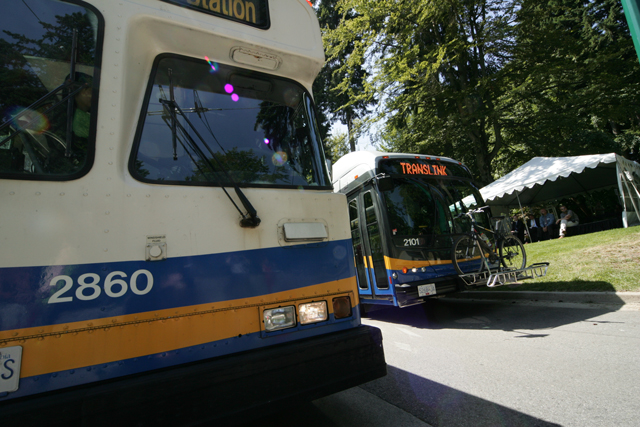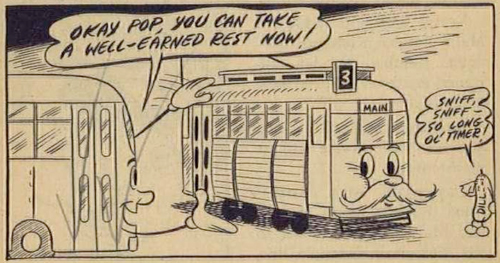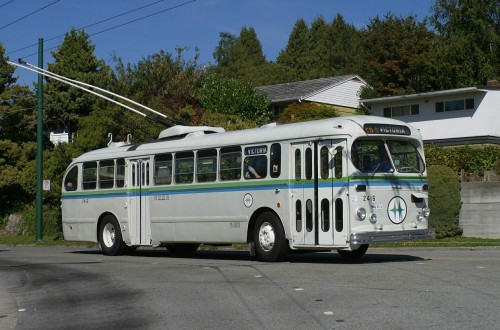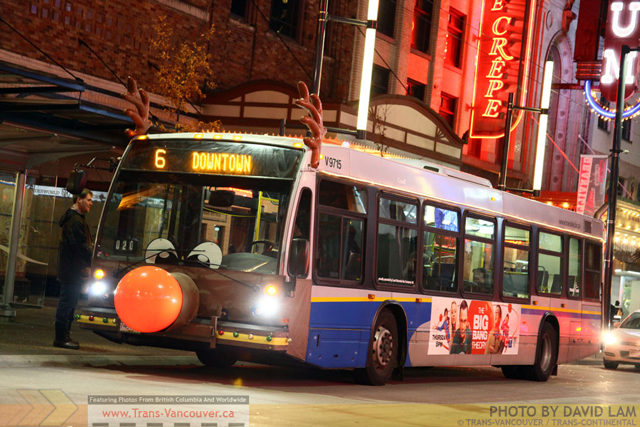Friday fun guest post: It’s all about the numbers… on the bus, by Michael Taylor-Noonan
Friday fun guest post: It’s all about the numbers… on the bus, by Michael Taylor-Noonan

For this Friday fun post, Michael Taylor-Noonan, the editor of the Transit Museum Society‘s newsletter has kindly contributed a piece on the history of bus numbering! Read on for a deep dive into the numbers we see today.
For this first guest blog, I’ve decided to write about bus numbers – not the ones on the front that tell you where your bus is headed, but the ones on the side, back and front that distinguish one bus from hundreds of identical vehicles. For years this was known as a ‘unit’ number, but now it can be called an asset number, fleet number, or bus number, depending on who you are talking to.
In the beginning….
Back in the beginning when public transit came to B.C—in this case Victoria in February 1890—the transit company merely purchased some streetcars: the first one was numbered ‘1’, the second ‘2’, and so on.
Four months later, Vancouver got its streetcar service, and also numbered them consecutively, but with a twist. The local transit company had six cars, but numbered them 10 – 15. Apparently, such a ruse to inflate importance of a transit operation was well known – other cities numbered with only even or odd numbers, doubling the size of their system (footnote 1).
In 1897 the Victoria and Vancouver systems passed to a new company, B.C. Electric Railway Co. Thanks to that early decision about numbers, both fleets merged together quite well, without need for much renumbering. As new streetcars were purchased, they were numbered consecutively, with no allowance made for the location (Victoria, Vancouver, and then New Westminster and North Vancouver).
Buses, then trolleybuses, would be introduced. But this common administration and operation would continue for another 102 years until 1999. That’s when TransLink began overseeing the Lower Mainland’s transit. All other transit systems remained with BC Transit, one of the modern day successors of the B.C. Electric Railway Co. But like ‘children of a common mother’, bus numbering in the 21st century can be traced back to this common ancestry.
Early bus numbering during the streetcar days
| Similar numbering in recent years… Many years later, Translink would initiate its Community Shuttle program, for much the same reasons as those early buses, and also prefix the vehicles, this time with an ‘S’, to keep them distinct. Coast Mountain Bus Company’s supervisors’ cars are similar: they are numbered with an ‘A’ prefix for ancillary. Again, the tradition continues throughout the years to this day. When, in 1980, BC Transit (a successor company to BC Electric) started its handi-dart custom services, these minibuses for people with disabilities were placed in a ‘C’ series. This later morphed into a ‘T’ series in Translink days – those are those yellow minibuses operated by contractor MVT Canadian Bus. |
When BC Electric introduced motorbuses in 1923, it was something of an experiment. Expanding streetcar service to new and sparsely populated areas was a very expensive proposition. Using buses was cheaper, but the company had historically only operated railed vehicles.
The new vehicles were numbered beginning at ‘1’ , though this time an ‘M’ (for ‘Motor’) was added before the number to identify a bus rather than a streetcar: ‘M1’,’ M2’ etc. As well, all service vehicles carried letter prefixes to show their function.
The vehicles were numbered consecutively with no internal structure to identify such things as manufacturer, vehicle type, location etc. It wasn’t long before somebody decided that was too simple, and some order must be placed on the apparent randomness of the numbers. One can readily appreciate this in those pre-computer days.
The BCER’s first attempt at order was the classification of its streetcar and interurban fleets. While the streetcar fleet was by-and-large numbered without any subgrouping, the interurbans (those big streetcars running out to Richmond & Chilliwack) had their own numbering system starting at 1000. (Interestingly, the first three were named rather than numbered! According to Brian’s Kelly’s book, they were named “Richmond”, “Steveston” and “Eburne.”) As different types of interurban entered the fleet, different series were allocated, from 1100 to 1800. (footnote 2)
Rails to rubber: trolleybus numbering
In 1947, the ‘rails-to-rubber’ trolleybus conversion program commenced. The replacement trolleybuses may have had had rubber tires, but they were not motor vehicles. As recently-retired long-time transit operator Angus McIntyre explains, because they did not have their own fuel source, they were considered as railway vehicles. This meant that the vehicles did not need licence plates (until 1973 when the regulations were changed), nor did operators need driver’s licences!
At first, the trolleybuses even followed the streetcar tracks and intending passengers had to walk out into the middle of the street to board. Because of their legal standing, the BCER extended its streetcar numbering system, rather than place them in the ‘M’ series. 1900 was free, but one suspects it was skipped so the new mode of transportation could be numbered in a new 2000 series.

When the second order of buses arrived in 1949, they were at first numbered continuing on from the where the first buses had stopped (2083). A few months later it was decided to separate the new buses and they were renumbered into a new series – 2100. Similarly as each new delivery of buses arrived, a new series was used, 2200 , then 2300 and finally 2400. The last batch contained just 16 vehicles, but when some second-hand buses from Birmingham, Alabama were purchased they were numbered in a 2500 series.
In 1975/6, the first Flyer trolleys arrived. Numbered 2601 – 50, they used reconditioned electrical components in newly constructed bodies. The next delivery of Flyers in 1983 were totally new buses, numbered 2701-2947. Of course, the ‘third-generation’ trolleys reverted back to 2100 numbers with the articulated units numbered 2500. Again, a nod to tradition.
Back to the motorbus. The fleet went from strength to strength. It was so successful that, in 1936/7, the BCER decided to replace streetcars in New Westminster entirely by buses. A new garage was opened equipped with 16 new buses plus a few draftees from Vancouver. Again, it was decided to isolate these vehicles in their own series. M200 and above was reserved for them.
In 1946/7, a similar thing happened in North Vancouver, and replacement buses were numbered above M800. Meanwhile in Vancouver, new deliveries of buses presented the problem of any ‘series’-related scheme— no more vacant numbers for new buses. The solution: renumber the New Westminster buses to above M900. (footnote 3)
Life after BC Electric

And this was how things stayed until the ‘provincialisation’ of the BC Electric Co in 1961/2, when BC Hydro was created. A new numbering scheme replaced the ‘M’ by a garage digit – 3 for Oakridge, 4 for North Vancouver and 5 for Burnaby (New Westminster having relocated in 1968.) Thus, in the 1964 renumbering, buses numbered in the 3000s operated along Vancouver streets from Oakridge. Over the years this would expand as new garages opened: 7000 – Surrey, and 9000 Port Coquitlam.
What about 6000 and 8000! Well, 6000 was reserved for the buses of BC Hydro’s inter-city line, Pacific Stage Lines. In 1984, the company was privatised, but almost twenty years later it was still numbering its coaches in the 6000 series! 8000 was reserved for BC Hydro (and later successor BC Transit) buses in Victoria. Though it wasn’t until 1991 you would actually see a Victoria bus numbered as such: until then, the ‘8’ was for accounting and maintenance purposes only.
Later in 1998, low-floor buses arrived with a new numbering scheme – the first two digits represented the year. West Vancouver originally numbered its buses in a random fashion, but it also adopted the same system: for example, nine Orions delivered in 1992 were numbered 921- 929.
You may think a system based on thousands left lots of room for expansion – one thousand vehicles in each group. Well, two things complicated the issue. The second digit of the unit number specified the type of vehicle, suburban or urban seating, highway transmissions and axles and so on. Some codes I know of include ‘5’ for a 35 foot long bus, ‘6’ for 102″ width, ‘8’ for 96″ width, and ‘9’ denoted deluxe bucket seating. I’m sure that there are others. Again, this system was developed to aid fleet administrators make sure that the type of bus suited the routes it worked upon. So the actual bus number was limited to 1 – 99.
No bus was numbered ending in ‘00’. John Day, a former transit planner, explains that older computer software systems were very limited. In tracking the transit fleet for such purposes of mileage balancing and battery and tire leasing, a way was needed to monitor a whole class of vehicles. The ‘phantom’ vehicle ending in ‘00’ was created to hold data for all the vehicles in that class. Of course, there are exceptions to everything, and for some reason bus 7200 is in service, but many years later trolleybus 2200 was renumbered 2289 before it began earning its keep.
It’s a fact of transit life that it’s best to balance mileage between buses. It’s awkward to have some similar aged vehicles with low mileage while others have millions of miles on them. One way to do this is to transfer buses between depots. Other reasons for transfers could be shifting demand. But either way, transferring buses around had an impact on bus numbering.
As John Day says, “BC Hydro and successors were constantly renumbering their buses. The reason had to do with the way vehicle maintenance was [tracked] by the accounting system — each garage’s
superintendent had an overall budget which was based upon the fleets under his control. Each fleet had a unique two-digit number which corresponded to the first two digits of the bus number. So when a North Vancouver [bus] was transferred to Oakridge, it couldn’t keep its 4600 series number, it had to become a 3500. Transfer the same bus to Kensington and it became a 5600, etc.”
Some buses spent only weeks at their new depot before heading back from where they came. In a perfect world, the bus could get its old number back, but sometimes things didn’t work out that way, and a new number was assigned. Some vehicles from the seventies and eighties have had six or seven different numbers applied: a system that could be confusing.
Today’s system

And so in 1996, the current ‘prefix’ system was introduced. The garage prefixes were V for Vancouver, B for Burnaby, N for North Vancouver, P for Port Coquitlam, S for Surrey, and later, R for Richmond. (The eagle-eyed amongst you may have seen ‘T’ and ‘H’. These are not depots, but the Training Department, and Heavy Overhaul respectively.)
Under this system the bus unit number will remain the same for the vehicle’s entire life, only the prefix will change with depot transfers. The time and cost to change this is minimal compared to past numbering systems, and most of the tracking of vehicle expenses is done with more sophisticated software programs and accounting practices. But the basic structure remains as it was in 1964, using four digit unit numbers. New Flyer natural-gas powered buses occupy 3xxx, along with, interestingly, those that were converted to diesel. New Flyer low-floor diesels are numbered 7xxx, articulated New Flyers, 8xxx. Newer Novabus vehicles are 9xxxx, and Orion suburbans 92xx.
Deciding to renumber buses is not something to be undertaken lightly. All maintenance and other records pertaining to each bus have to be meticulously cross-referenced to the original number. So too, re-using bus unit numbers can lead to confusion. That’s why the new buses are numbered in the higher ranges. Unlike that first Vancouver transit system, Coast Mountain isn’t trying to impress — make you believe it has 9000 buses. But rather, when buses were renumbered in 1996, older buses occupied the 1100, 1200, 4000, 5000, 6000, 9100 and 9900s. Much better to avoid those numbers in the future.
So you can see, choosing a number for that bus you’re riding in is a complicated process, combining logic, convenience and planning, but retaining a little bit of tradition.
Footnotes
1. Kelly, Transit in British Columbia, Maderia Park: Harbour Publishing, Pg 17
2. The Story of the BC Electric, Henry Ewert, North Vancouver: Whitecap Books, 1986.
3.This information is from an unpublished history of Vancouver’s buses by Peter Cox.
Thanks Michael! Bear in mind that I’m not a numbering expert so I may not have many answers to your questions on this article… Michael or others may chime in though!






[…] This post was mentioned on Twitter by The Buzzer and Graham Ballantyne, Graham Ballantyne. Graham Ballantyne said: I love it when the @buzzer posts super-nerdy articles like this one on bus numbering schemes. http://j.mp/gf3MY0 […]
This article is awesome!
Way awesome! Thanks again for the most informative guest post!
This article was really interesting. I always knew I rode buses that came out of the Richmond Depot, but until now never knew that the R prefix meant Richmond! Great article!
I would’ve like to see the trolleys continue with the 3000’s & go upwards to 9000’s, because some of the deisel buses (& some non trolley parts) are goina continue with the letter system “V”, “R”, “P”, etc., etc. With SkyTrain cars do start from 1 to 300’s (Newer Mk. II cars). My guess is that when SkyTrain reaches their 1999 car it will go back to 1 again, due to trolleys in the system. (If my calulations are correct)
How are community shuttles numbered?
The original shuttles, on Ford chassis, were numbered from S001 to S102. There was a mixtures of types, E350/450/550. The second generation, GMC’s are numbered S200 up (as far as S380). The GMC chassis (C5500) is no longer available, and Translink wishes to move to a low-floor vehicle. There is a trial vehicle numbered S400 in (I believe) Langley.
Why don’t he shuttles have the prefixes in front of the numbers?( “V”, “R”, “P”, “S”) to incate which depot it operated out of?
That I do not know, maybe Jhenifer can add some insight.
Ric, mtn: here is the response from our fleet management department.
I thought the shuttle was still run externally to save money on salaries. Why has been brought back to cmbc in 2003? Was the saving negligible?
???: Hmm… as far as I know, some shuttle services are run by CMBC and some are run by external contractors. I believe depending on the type of service, running the shuttle work ourselves may sometimes be the most cost effective and efficient option.
[…] the Transit Museum Society (TRAMS), for another guest post! (He previously wrote a guest post about bus numbering in Vancouver.) This time, Michael has kindly contributed an interview with Norm, a fellow TRAMS member who rode […]
[…] the newsletter editor for the Transit Museum Society! (He previously wrote guest posts about Vancouver bus numbers, and reminiscences of early Vancouver transit.) This time, Michael has kindly contributed a short […]
Hair
So what is the deal with our new articulated Xcelsiors being numbered by the year of acquisition (12xxx)?
Interesting article but it didn’t explain what those 3 digits in the box inside the front of the bus mean. Example 3x 8 001or x7x. Sometimes they are the same as the bus number but often the code seems to be a random digit. Very curious what these digits mean. I know 000 is a training vehicle, but what does this number mean?
The three-digit number in the little box in the front window is the block number of that specific bus. The block is the particular spot in the order or schedule of the route where that bus belongs. There are several buses running on the same route and each does a different block ensuring the timing and spacing stays consistent (as much as possible) For instance, one day I may drive the 2/99 which is Block 2 on the 99, then the 15/135. It is also how we identify a particular bus in mid-route that we may be picking up to start our shift as well, in case they get out of order (delays, etc). The X’s are just placeholders instead of leaving blanks. An instructor once told me to think of it this way: Imaging the route number is the team and the block number represents each player on the team. Easy to identify!
aren’t the T prefixes meant to indicate that the bus operates out of Hamilton Transit Centre? I’ve seen them on some 2016 New Flyer XN40’s and some Nova Buses too.